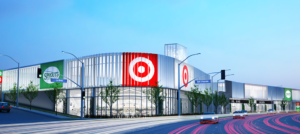Densification. How It’s Working In Retail.

Bigger isn’t always better. Gone are the days of ten-acre power centers with sprawling surface parking lots and large, at-grade loading docks. To remain competitive in today’s commercial real estate climate, retailers and developers alike are getting creative to maximize smaller spaces.
News of downsizing, rising land values and limited land supply is being met with retail use cases that make the best of growing densification. However, the fundamental question remains: how can we optimize real estate opportunities in urban neighborhoods while providing the customer with a seamless and convenient shopping experience?
The answer is simple.
Smart retailers are accounting for both topography and complementary brand operators to create successful – yet dense – commercial centers.
One recent example is the project completing construction at the intersection of La Brea Avenue and San Vicente Boulevard in Los Angeles. Developed by the CIM Group and leased by Xan Saks and Richard Rizika of Beta Agency, the project features three anchor tenants – Target (approximately 30,000 square feet), Sprouts (approximately 26,000 square feet), and Michaels (approximately 20,000 square feet) across two levels of retail. The developer was able to creatively utilize the topography change on the street to allow for both levels of the project to have street access as well as subterranean and rooftop parking. Perhaps most importantly, the site design allows for substantial brand presence. Target and Michaels have their storefront on La Brea, while Sprouts has theirs on San Vicente. The entire project is connected by a common vestibule in the middle of the site, which has vertical transportation to and from each level.
Surprisingly, the land parcel the development was constructed on is only approximately 70,000 square feet or 1.6 acres. To put that in perspective, if you were to develop a freestanding single level building with adequate surface parking on this land parcel, it would likely only be around 18,000 square feet. This developer was able to fit more than 75,000 square feet of leasable area on the same parcel by leveraging the grade changes of the street and seamless vertical design. Similarly, retailers are learning how to operate and co-exist with other retail partners on smaller sites.

Midtown Crossing is another recent example. A multi-level power center located at the crossroads of Venice, Pico, and San Vicente Boulevards in Los Angeles, it was designed to take advantage of the topography change on each of the streets it intersects. The lowest level features Lowe’s Home Improvement as its anchor. This level has at-grade vehicular access and frontage to Pico Boulevard. The upper level features Smart & Final Extra, Ross Dress for Less, Bob’s Discount Furniture, Petsmart, and ULTA. This level has at-grade vehicular access and frontage to Venice Boulevard. The 300,000 square foot center is conceptually one power center stacked directly on top of another. In a suburban market, a 300,000 square foot power center would likely require close to 28 acres to develop. In this case, Midtown Crossing sits on approximately 8 acres.

As large developable land continues to become scarce, developers and retailers must continue to find innovative ways to penetrate urban markets. Additionally, rising land values put more pressure on developers to find ways to add density to any development site. Lastly, many urban cities are further embracing updated zoning codes to allow for higher, larger and denser projects. While dense residential and office development is nothing new, retailers must adapt to this changing landscape in order to maintain a presence in many of the communities they would like to serve.